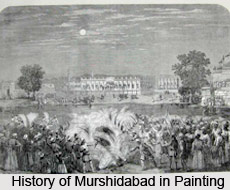 Murshidabad Painting was developed during the first quarter of the 18th century when Nawabs were ruling Bengal. Murshidabad painting appealed to both Hindus and Muslims. Murshidabad was a great centre of art and culture during the Pala rule. The Mughals also patronized art and culture. Some paintings of his time like Murshid Quli Khan holding darbar by the Bhagirathi River (c 1720), Muharram processions and festivals on Khwaja Khizir - are preserved.
Murshidabad Painting was developed during the first quarter of the 18th century when Nawabs were ruling Bengal. Murshidabad painting appealed to both Hindus and Muslims. Murshidabad was a great centre of art and culture during the Pala rule. The Mughals also patronized art and culture. Some paintings of his time like Murshid Quli Khan holding darbar by the Bhagirathi River (c 1720), Muharram processions and festivals on Khwaja Khizir - are preserved.
The styles of these paintings are regional. The real Murshidabad style of painting was encouraged under the next ruler Alivardi khan (1740-1756). He was an avid patron of art and culture. Some of the paintings entitled `Nawab Alivardi Khan hunting Roe Buck` (c 1750-1755), `Alivardi Khan seated on a Garden Terrace in conversation with his nephews` are famous.
Under Siraj - ud - daulah, the grandson of Alivardi Khan, Murshidabad painting reached its zenith. As he was liberal in his views it widened the horizon of Murshidabad court painting. His painters painted formal court scenes and scenes of conversation, cosy scenes of the zenana and ragamala scenes. A renewed vigour is noticed in the art activities of Siraj`s reign. Numerous raga and ragini scenes were depicted by the court artists. Hindola raga, gujari ragini, kakubha ragini, madhumadhavi ragini, bangali ragini are remarkable. Lovers amidst a romantic landscape or on a royal terrace or on a river cruise were the favourite painting themes of this period.
The Murshidabad artists painted on hand made papers in gouache and worked on Mughal qalam. The motifs of semi circular bushes bordering the terrace, the calm river with wading birds dotted on its banks; undulating hillocks are indicators of Murshidabad origin. Under Mir Jafar (1757-1760), Murshidabad paintings did not witness any remarkable change in the style of painting. Instead it lost its vitality and charm of Siraj`s period. During this period Puran Nath, a renowned artist from Lucknow joined the Murshidabad art scene. A beautiful painting by Puran Nath that depicts Nawab Mir Jafar and his son Miran inspecting armies amidst a vast field is one of the most beautiful paintings. Other miniature paintings represent the single portrait of the Nawab amidst barren natural settings; formal court scenes remind the style of Alivardi Khan`s art studio. The Lucknow painters continued to work under the next ruler Mir Qasim (1760-63).
Among them the renowned painter was Dip Chand who painted the famous portrait of Gurgan, a courtier of Mir Qasim. Formal court scenes of the Nawabs were also painted.
The arrival and prevalence of Lucknow artists brought about a sea change in the Murshidabad style.
The defeat of Mir Qasim by the English and the ascendancy of Mir Jafar for a second term disturbed the amiable atmosphere that was needed for the promotion of art and culture. Disbursed artists were employed to illustrate popular Hindu-Muslim manuscripts as well as picture albums containing portraits of Mughal rulers, nawabs, courtiers, representation of ragamalas. Among those Dastur-i-Himayat, Razamnama, Nala Damayanti, Nabwa Daman, Ragamala, and Nayaka-Nayikabheda miniatures received high praise. The artists also faithfully represented the flora and fauna of Bengal in an innocent and folk manner.



















